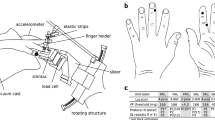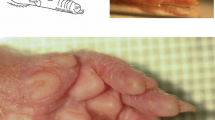Summary
Tactile sensations of flutter or pressure were evoked in alert human subjects by intraneural microstimulation in the median nerve. Ratings were obtained of the magnitude of sensations at threshold for conscious detection during movement of the finger to which they were projected, of neighbouring fingers or of the opposite hand. Results showed that inhibition of flutter sensation was maximal in the moved finger (48%), with a weaker graded effect from adjacent (23%) to distant (19%) fingers of the same hand. Sensations of pressure were more markedly suppressed but the gradients were similar. Movement of the opposite hand and isometric contraction of the forearm muscles had little effect. Local anaesthetic blocks of the median and other upper limb nerves counteracted most of the inhibitory effect of movement on cutaneous flutter sensation. We conclude that sensory gating is largely restricted to the moved digits, that it applies to submodalities of both flutter and pressure and that sensory gating is mostly mediated by cutaneous receptor input from the hand.
Similar content being viewed by others
References
Abbruzzese G, Abbruzzese M, Favale E. Ivaldi M, Leandri M, Ratto S (1980) The effect of hand muscle vibration on the somatosensory evoked potential in man: an interaction between lemniscal and spinocerebellar inputs? J Neurol Neurosurg Psychiatr 43: 433–437
Abbruzzese G, Ratto S, Favale E, Abbruzzese M (1981) Proprioceptive modulation of somatosensory evoked potentials during active or passive finger movements in man. J Neurol Neurosurg Psychiatr 44: 942–949
Angel W, Weinrich M, Siegler D (1985) Gating of somatosensory perception following movement. Exp Neurol 90: 395–400
Angel RW, Weinrich M, Rodnitzky R (1986) Recovery of somatosensory evoked potential amplitude after movement. Ann Neurol 19: 344–348
Chapin JK, Woodward DJ (1982) Somatic sensory transmission to the cortex during movement: gating of single cell responses to touch. Exp Neurol 78: 654–669
Chapman CE, Bushnell MC, Miron D, Duncan GH, Lund JP (1987) Sensory perception during movement in man. Exp Brain Res 68: 516–524
Cohen LG, Starr A (1985) Vibration and muscle contraction affect somatosensory evoked potentials. Neurology 35: 691–698
Cohen LG, Starr A, (1987) Localization, timing and specificity of gating of somatosensory evoked potentials during active movement in man. Brain 110: 451–467
Coquery J-M (1972) Modifications des potentiels évoqués corticaux somesthésiques durant des mouvements actifs et passifs chez l'homme. Electroencephalogr Clin Neurophysiol 33: 269–276
Coquery J-M (1978) Role of active movement in control of afferent input from skin in cat and man. In: Gordon G (ed) Active touch. Pergamon Press, Oxford New York, pp 161–169
Ghez C, Pisa M (1972) Inhibition of afferent transmission in cuneate nucleus during voluntary movement in the cat. Brain Res 40: 145–151
Hulliger M, Nordh E, Thelin A-E, Vallbo ÅB (1979) The responses of afferent fibres from the glabrous skin of the hand during voluntary finger movements in man. J Physiol (Lond) 291: 233–249
Jones SJ (1981) An ‘interference’ approach to the study of somatosensory evoked potentials in man. Electroencephalogr Clin Neurophysiol 52: 517–530
Milne RJ, Aniss AM, Kay NE, Gandevia SC (1988) Reduction of percieved intensity of cutaneous stimuli during movement: a quantitative study. Exp Brain Res 70(3): 569–576
Nelson RJ (1984) Responsiveness of monkey primary somatosensory cortical neurones to peripheral stimulation depends on motor set. Brain Res 304: 143–148
Nishihira Y, Araki H, Ishihara A (1987) Changes in central somatosensory pathways accompanying reaction movements. Percept Mot Skills 64: 1251–1260
Ochoa J, Torebjörk E (1983) Sensations evoked by intraneural microstimulation of single mechanoreceptor units innervating the human hand. J Physiol (Lond) 342: 633–654
Papakostopoulos D, Cooper R, Crow HJ (1975) Inhibition of cortical evoked potentials and sensation by self-initiated movement in man. Nature 258: 321–324
Rushton DN, Rothwell JC, Craggs MD (1981) Gating of somatosensory evoked potentials during different kinds of movement in man. Brain 104: 465–491
Schady WJL, Torebjörk HE (1983) Projected and receptive fields: a comparison of projected areas of sensations evoked by intraneural stimulation of mechanoreceptive units, and their innervation territories. Acta Physiol Scand 119: 267–275
Schmidt RF, Schady WJL, Torebjörk HE (1989) Gating of tactile input from the hand. I. Effects of finger movement. Exp Brain Res 79: 97–102
Starr A, Cohen LG (1985) ‘Gating’ of somatosensory evoked potentials begins before the onset of voluntary movement in man. Brain Res 348: 183–186
Tapia MC, Cohen LG, Starr A (1987) Selectivity of attenuation (i.e., gating) of somatosensory potentials during voluntary movements in humans. Electroencephalogr Clin Neurophysiol 68: 226–230
Torebjörk HE, Ochoa J (1980) Specific sensations evoked by activity in single identified sensory units in man. Acta Physiol Scand 110: 445–447
Tsumoto T, Nakamura S, Iwama K (1975) Pyramidal tract control over cutaneous and kinesthetic sensory transmission in the cat thalamus. Exp Brain Res 22: 281–294
Author information
Authors and Affiliations
Rights and permissions
About this article
Cite this article
Schmidt, R.F., Torebjörk, H.E. & Schady, W.J.L. Gating of tactile input from the hand. Exp Brain Res 79, 103–108 (1990). https://doi.org/10.1007/BF00228878
Received:
Accepted:
Issue Date:
DOI: https://doi.org/10.1007/BF00228878




